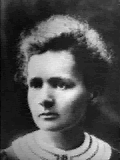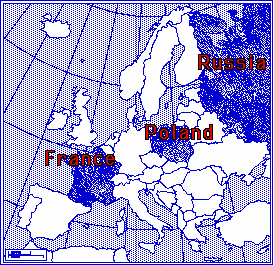 |
Madame Curie was born Maria Sklodowski in Warsaw, Poland in 1867, the youngest of five children. When she was born, Poland was controlled by Russia. Her parents were teachers, and she learned at an early age the importance of education.
Her mother died when she was young, and when her father was caught teaching Polish - which had been made illegal under the Russian government. Manya, as she was called, and her sisters had to get jobs. After a couple of failed jobs, Manya became a tutor to a family in the countryside outside Warsaw. She enjoyed her time there, and was able to send her father money to help support him, and also send some money to her sister Bronya in Paris who was studying medicine.
Bronya eventually married another medical student and they set up practice in Paris. The couple invited Manya to live with them and study at the Sorbonne - a famous Parisian University. In order to fit in better at the school, Manya changed her name to the French "Marie." Marie studied physics and mathematics and quickly received her masters' degrees in both subjects. She remained in Paris after graduation and started research on magnetism.
For the research she wanted to do, she needed more space than her small lab. A friend introduced her to another young scientist, Pierre Curie, who had some extra room. Not only did Marie move her equipment into his lab, Marie and Pierre fell in love and married.
A friend of the Curies, A. Henri Becquerel, had been playing with recently discovered properties of the element uranium. He talked to Pierre and Marie about those properties and they became interested in them too. Marie Curie set about investigating the effect, which she named "radio-activity" for her Doctorate research.
Marie Curie checked many other elements to determine whether they too were radioactive. She found one, thorium, and also came across a source of radiation in a mixture called "pitch-blend," which was much more powerful than either thorium or uranium.
Working together, it took Marie and Pierre four years to isolate the radioactive source in the pitch-blend. Marie named it radium. For the discovery of radium, Marie and Pierre won a Nobel Prize in Physics in 1903, which they shared with their friend A. Henri Becquerel. Shortly, Marie found that what she had discovered was not pure radium, but she was able to isolate the element itself after quite a struggle. For this work, she was given the Nobel Prize for Chemistry in 1911.
During her work, Marie discovered radiation could kill human cells. She reasoned that if it could kill healthy human cells, it could kill diseased human cells and went about isolating radium for use in killing tumors.
In 1906 Pierre Curie was offered the position of director of the Physics Laboratory at the Sorbonne. Before he could take the position, however, he was run over by a carriage and killed. After her husband died, Marie was offered and took the position, the first woman to become director of a research laboratory.
 |
During the first World War, Marie Curie went to work for the French building and designing X-ray machines. Knowing that moving soldiers to a hospital before they needed surgery was not always possible, she designed the first mobile X-ray machine and traveled with it along the front lines during the war.
On July 4, 1934, Marie Curie died in Paris, killed by her own experiments. She died of radiation poisoning and may have been the first person to do so. Marie Curie had brought herself up from poverty, struggling to get her education and succeeding brilliantly. The work she did, she did with patience, often getting results only after years of careful experimentation, while struggling for money to support her work. For her struggles, she received two Nobel Prizes - the first woman to win even one. Through the knowledge she gained, thousands of lives have been saved.
Great knowledge, however, is often a two-edged sword. Without the work she did we might not have many modern cancer treatments, or atomic clocks, or even the computer you're viewing this on. But through her work on radioactivity she can also be thought of as the mother of the atomic bomb.
Page created on 7/11/2015 3:38:44 PM
Last edited 1/7/2020 8:02:15 PM

Cliquez ici pour lire l'histoire en français
| "Marie Curie is my hero because she shows determination, and that if you keep at your goal you will get what you want. She was an inventor and a scientist. She discovered radium and she invented the first mobile x-ray machine so that soldiers could be x-rayed in the field when they were hurt. I thought it was neat that she was the first woman to receive the Nobel Prize for science." |